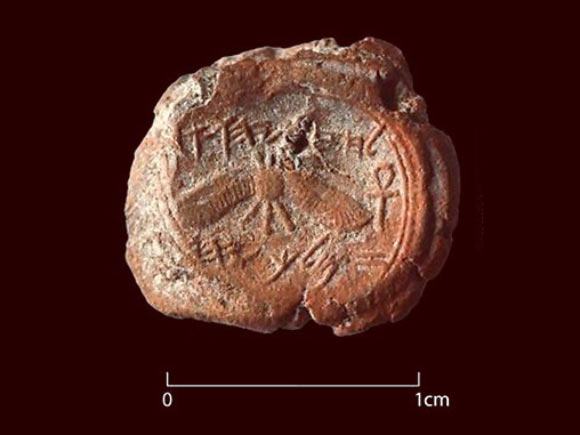Israeli archaeologists digging in the Ophel Archaeological Park, near the Southern Wall of the Temple Mount in Jerusalem’s Old City, have discovered an ancient clay bulla bearing the name of Hezekiah, King of Judea (727-698 BC).

A seal impression of King Hezekiah unearthed at the foot of the Southern Wall of the Temple Mount. Image credit: Ouria Tadmor / Eilat Mazar.
The newly discovered bulla – a lump of clay bearing a seal impression – is about 2,700 years old.
It measures 12 by 13 mm, and is stamped with an oval seal, 8.6 by 9.7 mm.
The impression bears an inscription in ancient Hebrew script:
“לחזקיהו [בן] אחז מלך יהדה”
“Belonging to Hezekiah [son of] Ahaz king of Judah.”
The symbols on the seal impression – a two-winged Sun, with wings turned downward, flanked by two ankh symbols symbolizing life – suggest that they were made late in King Hezekiah’s life.
“Although seal impressions bearing King Hezekiah’s name have already been known from the antiquities market since the middle of the 1990s, some with a winged scarab symbol and others with a winged Sun, this is the first time that a seal impression of an Israelite or Judean king has ever come to light in a scientific archaeological excavation,” said Dr Eilat Mazar from Hebrew University of Jerusalem.
“The bulla originally sealed a document written on a papyrus rolled and tied with thin cords, which left their mark on the reverse of the bulla,” he said.
“It was found together with 33 additional bullae imprinted from other seals, some bearing Hebrew names, their reverse showing marks of coarse fabric and thick cords that probably sealed sacks containing foodstuffs.”
King Hezekiah is described favorably in the Bible as well as in the chronicles of the Assyrian kings – Sargon II and his son Sennacherib – who ruled during his time.
“Hezekiah is depicted as both a resourceful and daring king, who centralized power in his hands. Although he was an Assyrian vassal, he successfully maintained the independent standing of the Judean Kingdom and its capital Jerusalem, which he enhanced economically, religiously, and diplomatically,” the archaeologists said.
The Bible relates of Hezekiah that “there was none like him among all the kings of Judah after him, nor among those before him” (II Kings 18:5).







